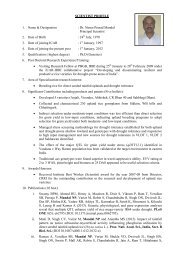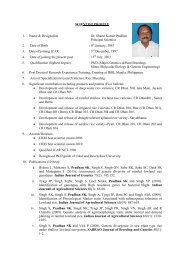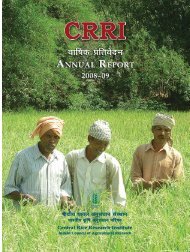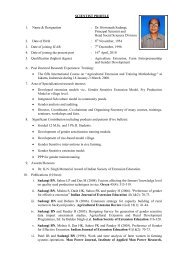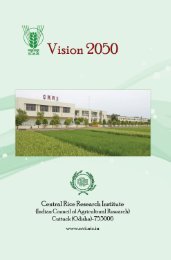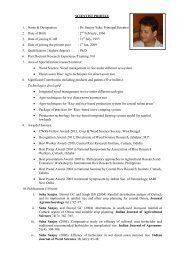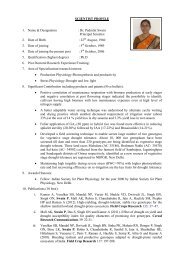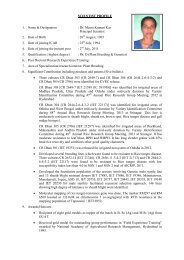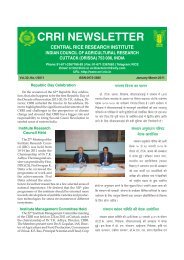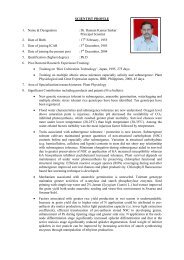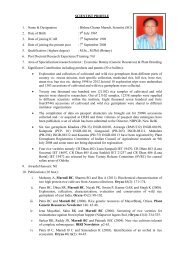Dr H.N. Subudhi, Senior Scientist - Central Rice Research Institute
Dr H.N. Subudhi, Senior Scientist - Central Rice Research Institute
Dr H.N. Subudhi, Senior Scientist - Central Rice Research Institute
- No tags were found...
You also want an ePaper? Increase the reach of your titles
YUMPU automatically turns print PDFs into web optimized ePapers that Google loves.
SCIENTIST PROFILE<br />
1. Name & Designation : <strong>Dr</strong>. Hata Nath <strong>Subudhi</strong><br />
<strong>Senior</strong> <strong>Scientist</strong><br />
2. Date of Birth : 10 th December, 1961<br />
3. Date of joining ICAR : 21 st July, 1993<br />
4. Date of joining the present post : 21 st July, 2003<br />
5. Qualification ( highest degree) : Ph.D (Botany)<br />
6. Post Doctoral <strong>Research</strong> Experience/Training:<br />
Training:” Genetic evaluation and utilization” held at Ubon <strong>Rice</strong> <strong>Research</strong> Centre, Thailand<br />
11 th September–20 th October, 2000.<br />
7. Area of Specialization/research interest:<br />
• Plant taxonomy and biodiversity conservation. Bio diversity studies of mangroves,<br />
wetland plants, medicinal plants and their conservation. Exploration, collection,<br />
characterization and conservation of rice genetic resources including aromatic rice and<br />
wild relatives of cultivated rice.<br />
8. Significant Contribution including products and patents (Five bullets):<br />
• Collection, identification of forage legumes and grasses in Rajasthan.<br />
• Identification of some new records of weed species from forage fields of Jhansi<br />
• Collection, characterization of rice genetic resources in general and aromatic short grain<br />
rice in particular.<br />
• Studies on physico-chemical and cooking characters in released rice varieties.<br />
• Demonstration of popular rice varieties and evaluation of yield characters over seasons.<br />
9. Awards/Honours:<br />
• <strong>Scientist</strong> of the year award National Environmental Science Academy, New Delhi.<br />
• Eminent scientist award of National Environmental Science Academy, New Delhi.<br />
10. Publications (10 best):<br />
i. <strong>Subudhi</strong> HN, Das Sanjukta, Swain D, Singh ON and Sharma SG (2012). Studies on<br />
Grain Yield, Physico-Chemical and Cooking Characters of Elite <strong>Rice</strong> Varieties (Oryza<br />
sativa L.) in Eastern India. Journal Agriculture Sciences 4(12): 269-275.<br />
ii. <strong>Subudhi</strong> HN, Swain D Samantaray S and Singh ON (2012). Collection and agromorphological<br />
characterization of aromatic short grain rice in eastern India. African<br />
Journal Agricultural <strong>Research</strong> 7(36): 5060-5068.<br />
iii. <strong>Subudhi</strong> HN and Das Sanjukta (2011). Evaluation and selection of long slender<br />
Aromatic rice (Oryza sativa L.) for higher profit in Eastern India. Indian Journal<br />
Agriculture Science 81(7): 654-656.<br />
iv. <strong>Subudhi</strong> HN, Meher J, Bose LK and Das Sanjukta (2009). Genetic diversity studies of<br />
promising rice varieties of Eastern India based on quality characters. Oryza 46(4): 271-<br />
274.<br />
v. <strong>Subudhi</strong> HN, Bose LK, Prasad D and Swain D (2008). Genetic diversity studies in<br />
promising lowland rice varieties. Oryza 45(4): 273-276.<br />
vi. <strong>Subudhi</strong> HN, Swain D, Panda SP and Choudhury B P (2008). Bio-diversity of wild<br />
rices in Orissa and necessity for conservation. Bulletin Pure and Applied Sciences 27B<br />
(1-2): 1-12.
vii.<br />
viii.<br />
ix.<br />
<strong>Subudhi</strong> HN and Padhi G (2008). Field evaluation of rice cultivars against the yellow<br />
stem borer Scirpophaga incertulas (wlk.). Oryza 45(3): 222-225.<br />
<strong>Subudhi</strong> HN, Panda SP and Nayak PK (2002). Systematic enumeration of plant from<br />
Malpura and adjoining regions (Rajasthan). Bulletin Pure and Applied Sciences<br />
21B(2): 77-86.<br />
<strong>Subudhi</strong> HN, Saha D and Choudhury BP (2000). Collection of Desmodium Desf. and<br />
its wild relatives from Orissa and necessity for conservation. Journal Econ. Tax. Bot.<br />
24(3): 695-699.<br />
x. <strong>Subudhi</strong> HN, Vinod Shankar and Singh JP (1997). Forage Desmodiums: Ecology and<br />
potentials. Indian Journal Plant Genetic Resources 10(1): 97-109.



